Categories: Sources of light, Energy saving
Number of views: 193,620
Comments on the article: 56
Five myths about energy-saving lamps
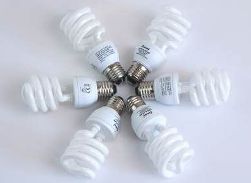 Around compact luminescent, so-called. energy saving lamps Recently there have been many rumors and myths. In this article, we will try to dispel some of the most common myths.
Around compact luminescent, so-called. energy saving lamps Recently there have been many rumors and myths. In this article, we will try to dispel some of the most common myths.
I’ll note right away that the article will focus on compact fluorescent tubes. Other energy-saving light sources used in home lighting - LED and halogen lamps (if compared in terms of energy saving with incandescent lamps, they can also be called energy-saving) will not be considered.
The first myth. Energy-saving lamps emit UV rays that are harmful to health.
It is known that light has on the human body affects the metabolism in the body, physical development and human health. The most useful in this regard is daylight (light from the sun). In artificial light when using incandescent lamps (thermal light sources) is completely absent ultraviolet radiation.
Ultraviolet radiation in the volume that we receive from energy-saving lamps is not only not harmful, but even very useful for the human body. It relieves fatigue, eliminates depression, improves mood and is healthy, has a beneficial effect on health.
The ultraviolet light of energy-saving lamps can significantly reduce the problem of "light starvation", which is typical for people who spend most of their lives indoors under incandescent light and with a lack of natural light. It is scientifically proven that with a lack of ultraviolet radiation, the protective functions of the body decrease and the metabolism worsens.
For example, back in Soviet times, special ultraviolet irradiation plants were used for agriculture, which compensated for the lack of natural ultraviolet radiation in the winter and when keeping animals indoors.
Excessive ultraviolet radiation alone can lead to health problems (skin and eye diseases). The ultraviolet irradiation of energy-saving lamps was investigated and proved that even when using fluorescent lamps to create very high levels of illumination (1000 LK) and working in this room for eight hours, the dose of ultraviolet radiation in this case is only one hour per day outdoors at noon.
Conclusion: talking about the dangers of ultraviolet radiation from conventional energy-saving lamps, taking into account all of the above, is not serious, it is a myth and benefits in that such lamps have a lot more ultraviolet radiation in their spectrum for human health and mental state.
The second myth. Energy-saving lamps have a poor effect on vision.
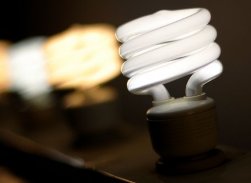 This myth was born from the experience of using ordinary enterprises and administrative buildings. fluorescent tubes. The fact is that old-style linear fluorescent lamps are connected to the mains using a special device - electromagnetic ballast, which includes an inductor, starter and capacitors.
This myth was born from the experience of using ordinary enterprises and administrative buildings. fluorescent tubes. The fact is that old-style linear fluorescent lamps are connected to the mains using a special device - electromagnetic ballast, which includes an inductor, starter and capacitors.
After turning on such a lamp, the luminous flux of such a lamp during operation changes in time (pulsates) 100 times per second. Such a pulsation, although it is not directly captured by the eye, nevertheless, with prolonged work, has a negative effect on a person, causing his fatigue and decreased performance.
Modern energy-saving lamps used for ignition and work electronic ballasts (electronic ballasts), which increase the frequency of the supply voltage on the lamp. All energy-saving lamps with E14 and E27 sockets have a built-in electronic ballast in the lamp base, which completely eliminate the negative effect of pulsed light flux on vision.
Here you need to be careful only with the application energy saving lamp pins. Most often, such lamps in everyday life are used in table lights. For such lamps, ballasts are built into the lamp itself. 2-pin lamps work only from electromagnetic ballasts, 4-pin lamps can work both from electromagnetic and electronic ones. Just when buying, you need to be interested in the configuration and technical characteristics of the lamp and the types of lamps that can be used in it.
The fact that energy-saving lamps create less contrast lighting, according to ophthalmologists, even has a beneficial effect on vision, since diffused light reduces eye fatigue and makes light more comfortable in the room.
The third myth. Energy-saving lamps light up for a long time.
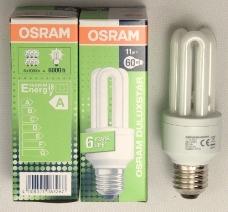 All modern energy-saving lamps light up almost instantly, since they are used to start such lamps electronic ballast. True, such a lamp reaches its full radiation power in a few seconds, but, nevertheless, this process is practically not noticeable for human perception.
All modern energy-saving lamps light up almost instantly, since they are used to start such lamps electronic ballast. True, such a lamp reaches its full radiation power in a few seconds, but, nevertheless, this process is practically not noticeable for human perception.
This myth also came to us from the experience of using old linear fluorescent lamps, because they are turned on using conventional electromagnetic ballasts, and the process of turning them on takes a certain time. It happens that such lamps for a number of reasons do not light up the first time, but a second, and even third attempt is required, while the lamps constantly blink.
Pin energy-saving lamps that receive power through electromagnetic ballasts can behave similarly, but this is not the fault of the lamp, but a technically-imperfect start-up and regulating device.
The fourth myth. Energy-saving lamps flash off
This myth was created by people who, before replacing incandescent lamps with energy-saving ones, used illuminated switches, usually a LED or a neon bulb integrated into the circuit breaker housing. When the keys of such a switch are turned off, the LED shunts the contact of the switch and at the same time a small current flows through the energy-saving lamp.
When using conventional switches without backlight, energy-saving lamps do not blink when turned off. After turning off the lamp, the phosphor may be in a slightly luminous state for some time, then this glow decreases.
If you find yourself in a situation with a backlit switch, then in this case you can either refuse the backlight (by getting rid of the LED in the switch), or connect another resistor in parallel with the lamp.
You can experiment with different lamps. For example, 15 W energy-saving lamps flickered, and when I put the 13 W lamp on, the flicker stopped. The easiest option is to change not all the lamps, but leave one incandescent lamp in the chandelier, then the lamps will not blink.
The fifth myth. Energy-saving lamps are not suitable for lighting living rooms, because in the light of such lamps everything around looks dead white.
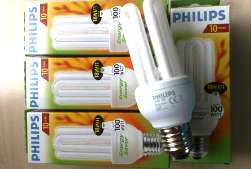 This myth is formed in people in whom linear fluorescent lamps are clearly associated with the name “fluorescent lamp”. Such lamps are widely used in office buildings and industrial enterprises. In fact, the color of modern energy-saving lamps does not have to be just “dead white.”
This myth is formed in people in whom linear fluorescent lamps are clearly associated with the name “fluorescent lamp”. Such lamps are widely used in office buildings and industrial enterprises. In fact, the color of modern energy-saving lamps does not have to be just “dead white.”
Various energy-saving lamps can emit light with different emission spectrathat makes the use of energy-saving lamps instead of incandescent lamps even more comfortable, as the color palette of home lighting is enriched.
The color parameters and color rendering quality are indicated on the lamp packaging (the quality of light depends on these two parameters). The color of the lamp is determined by its color temperature and lies in the range from 2700 to 6500 K.
Color rendering index determines how well a given lamp conveys various colors. The color rendering index of compact fluorescent lamps is in the range of 60 - 98.The larger the number, the better the color reproduction.
For residential premises, it is necessary to choose lamps with a color temperature of 2700 - 3100 K and with a color rendering index of more than 80. Cold light lamps should be used mainly in office premises (3300 - 6500 K).
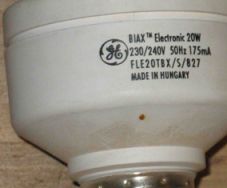 The color rendering index and color temperature of energy-saving lamps can be determined by their marking on the lamp itself or on the packaging.
The color rendering index and color temperature of energy-saving lamps can be determined by their marking on the lamp itself or on the packaging.
For example, on the base of an energy-saving lamp, the number 827 is written from the photograph. This means that the lamp has a color rendering index of 80 and a color temperature of 2700 K (as with ordinary incandescent lamps).
Unfortunately, most people buying energy-saving lamps focus primarily on price, and most inexpensive lamps are available with cheap phosphors emitting white light (4000 K). Low-cost, energy-saving warm light bulbs are also available, but with mediocre color reproduction.
Conclusion: When buying energy-saving lamps, pay attention to their color temperature and color rendering index.
In places that we visit for a short time (pantries, a bathroom, an attic, etc.) it is not economical to use energy-saving lamps. Replacing incandescent lamps with energy-saving lamps is first of all necessary precisely in living rooms, i.e. exactly where the lamp will work at least 2-3 hours a day. In this case, an energy-saving lamp (in my opinion, in our time, this is the most optimal light source for the home) will bring the greatest benefit and replacing incandescent lamps with energy-saving lamps will be most profitable.
What do you think about this?
See also: The reasons for the flashing of a compact fluorescent lamp and methods for solving this problem
Another common myth about energy-saving lamps. Comparison of mercury in a conventional thermometer and lamp. Thermometer must be prohibited!
See also at e.imadeself.com
:
